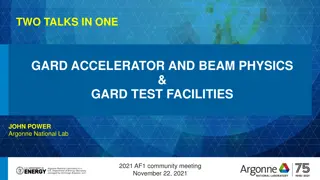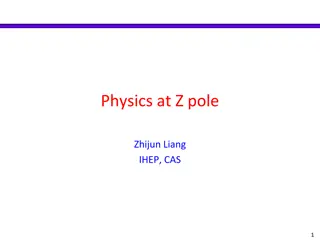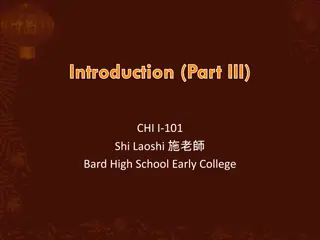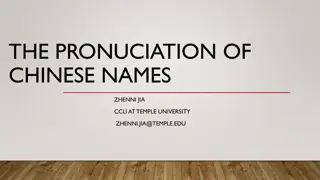Advancements in Chinese High-Energy Physics Research
Initiatives like the CEPC-SppC Study Group and Circular Electron Positron Collider (CEPC) showcase China's commitment to pioneering future collider projects. With a focus on the energy frontier, developments such as the upgrade to a 50-70 TeV pp collider indicate significant progress in the field. The proposals aim to enhance scientific discoveries and technological advancements, positioning China strategically to contribute to high-energy physics globally.
Download Presentation

Please find below an Image/Link to download the presentation.
The content on the website is provided AS IS for your information and personal use only. It may not be sold, licensed, or shared on other websites without obtaining consent from the author.If you encounter any issues during the download, it is possible that the publisher has removed the file from their server.
You are allowed to download the files provided on this website for personal or commercial use, subject to the condition that they are used lawfully. All files are the property of their respective owners.
The content on the website is provided AS IS for your information and personal use only. It may not be sold, licensed, or shared on other websites without obtaining consent from the author.
E N D
Presentation Transcript
Chinese Initiatives on Future Circular Collider Hongbo Zhu (IHEP) On behalf of the CEPC-SppC Study Group Next Steps in the Energy Frontier Hadron Colliders FermiLab, 25-29 August 2014
After the Higgs Discovery Higgs factory ideas bloom photo credit: symmetry Institute of High Energy Physics FermiLab Workshop, 25 -29 August 2014 2
Chinese Proposal The idea of Circular Electron Positron Collider (CEPC) as Higgs Factory proposed at several national Accelerator Based HEP Program workshops in 2011-2012, even before the Higgs discovery At the workshop in September 2012, the idea to upgrade CEPC to a 50-70 TeV pp collider (SppC) adds life and physics potentials to the project; the option of CEPC-SppC seriously discussed in October 2012; the CEPC-SppC kick-off meeting on 13-14 September 2013 Presented by Dr Qing QIN at HF2012 Institute of High Energy Physics FermiLab Workshop, 25 -29 August 2014 3
Dr Y. Wangs talk at the FCC kickoff meeting In Practice A circular Higgs factory fits our strategic needs in terms of Science (great & definite physics) Timing (after BEPCII) Technological feasibility (experience at BEPC/BEPCII and other machines in the world), Manpower reality (our hands are free after ~2020) Economical scale (although slightly too high) The risk of no-new-physics is complement by a pp collider in the same tunnel A definite path to the future A unique position for China to contribute at this moment: Economical growth new funding to the community Large & young population new blood to the community Affordable tunnel & infrastructure If no new project, no new resources It is a pity if we miss it Institute of High Energy Physics FermiLab Workshop, 25 -29 August 2014 4
Outline Circular Electron Positron Collider (CEPC) Physics motivation Accelerator design Detector design Super proton-proton Collider (SppC) Physics motivation Accelerator design Superconducting magnets Timeline, organization, candidate site Summary Institute of High Energy Physics FermiLab Workshop, 25 -29 August 2014 5
Circular Electron Positron Collider (CEPC) Institute of High Energy Physics FermiLab Workshop, 25 -29 August 2014 6
Physics Motivation Precise measurements of the Higgs properties as a Higgs Factory and similar to ILC@250 GeV Mass, JPC, couplings, etc. (sub-)percentage accuracy Precise measurements of Electroweak Symmetry-Breaking parameters (machine operated at Z-pole/WW threshold) and etc. + searches for rare decays , , sin , , , S W Z W m 2 eff Zm arXiv:1303.3879 [hep-ph] Institute of High Energy Physics FermiLab Workshop, 25 -29 August 2014 7
Accelerator Baseline Design to generate and accelerate electrons to 6 GeV to accelerate electrons to 120 GeV LINAC Booster Main Ring to accumulate electrons to 16.9 mA, FODO lattice, single ring with the Pretzel scheme LTB e+ e- IP1 BTC e+ e- Linac (240m) BTC IP2 More details in Dr Qing QIN s talk Institute of High Energy Physics FermiLab Workshop, 25 -29 August 2014 8
Basic Machine Parameters CEPC machine parameters Number of IPs 2 Emittance x/y nm 6.9/0.021 Beam energy GeV 120 Transverse IPx/y m 74.3/0.16 Circumference km 50 x/IP 0.097 SR loss/turn GeV 3 y/IP 0.068 Ne/bunch VRF GeV 6.87 3.5 1011 Bunch number 50 Nature bunch length Z mm 2.12 Beam current mA 16.9 Bunch length includes BS mm 2.42 SR power/beam mW 50 Nature energy spread % 0.13 B0 T 0.065 Energy acceptance RF % 5.4 Bending radius km 6 n 0.22 Momentum compaction factor % 0.07 0.4 10-4 BS IPx/y mm 800/1.2 Lmax/IP cm-2s-1 1.76 1034 Institute of High Energy Physics FermiLab Workshop, 25 -29 August 2014 9
Detector Concept ILD-like detector with additional considerations (incomplete list): Shorter L* (1.5/2.5m) constraints on space for the Si/TPC tracker No power-pulsing lower granularity of vertex detector and calorimeter Limited CM (up to 250 GeV) calorimeters of reduced size Lower radiation background vertex detector closer to IP Similar performance requirements to ILC detectors Momentum: recoiled Higgs mass / 1 GeV 10 5 p 5 = r % 4 3 E 5 -1 3 Impact parameter: flavor tagging, BR /( 10 sin ) m p 2 E Jet energy: W/Z di-jet mass separation Institute of High Energy Physics FermiLab Workshop, 25 -29 August 2014 10
Vertex Detector Pixel detector technologies on the market: CMOS Pixel Sensor (CPS), DEPFET, SOI, CCD, hybrid with 3D interconnection and operation experience from other experiments, e.g. CPS: STAR PX (MIMOSA28), ALICE ITS upgrade (MISTRAL/ASTRAL) DEPFET: Belle II vertex detector Without power-pulsing, it is difficult to remove heat sufficiently with air-cooling, possible solutions: Extra cooling material/larger pixel size degraded performance Innovative readout architecture with lower power consumption or novel cooling technology (e.g. micro-channel cooling) Preliminary study reveals radiation background likely lower than ILC placing the vertex detector closer to IP to improve c-tagging Detailed studies required to understand the impacts on physics performance Institute of High Energy Physics FermiLab Workshop, 25 -29 August 2014 11
Calorimeters Particle Flow Algorithm (PFA) driven calorimeters extensively explored by the CALICE collaboration; have started investigating the following technologies: DHCAL(ThGEM, RPC), SDHCAL (RPC), ECAL (SciW, SiW) Without power-pulsing, cooling of high-granularity calorimeters challenging due to the huge number of electronics channels less segmentation degraded detector performance Detailed studies required to understand the impacts on physics performance Institute of High Energy Physics FermiLab Workshop, 25 -29 August 2014 12
Higgs Couplings Comparison of the expected precision on Higgs couplings measurements from HL-LHC, ILC and CEPC. HL-LHC: 3 ab-1, one detector with the following assumption: g g SM , ~ g g H H H Hcc ILC 500: 250 fb-1@250 GeV + 500 fb-1@500 GeV CEPC: 2.5 ab-1@ 250 GeV, one detector e+e- collider ideally suited for measuring H invisibles And eventually a combination of results from all experiments Institute of High Energy Physics FermiLab Workshop, 25 -29 August 2014 13
Super proton-proton Collider (SppC) Institute of High Energy Physics FermiLab Workshop, 25 -29 August 2014 14
Physics Motivation High center-of-mass energy of O(100 TeV) allows for direct searches for New Physics like SUSY, Extra Dimensions, etc. unprecedented physics potentials To or not to re-define the physics program upon the (HL-)LHC results yet to come Dr L. Wang s talk at 1st CFHEP Symposium More discussion at this workshop Institute of High Energy Physics FermiLab Workshop, 25 -29 August 2014 15
Accelerator Baseline Design considerations Proton-proton collider luminosity 2 x =Nprp 4pen 2 p N N f 0.004 b rep = = + ( 1 ) c z L F F 0 4 2 , n IP x IP Main constraint: high-field superconducting dipole magnets 50 km: Bmax= 12 T, E = 50 TeV 50 km: Bmax= 20 T, E = 70 TeV 70 km: Bmax= 20 T, E = 90 TeV 2 ( ) B = B min C 0 Institute of High Energy Physics FermiLab Workshop, 25 -29 August 2014 16
work in progress Basic Machine Parameters Option 1 Option 2 SppC Machine Parameters Beam energy [TeV] 25 45 Circumference [km] 50 70 SR loss/turn [keV] 440 4090 Bunch population 1.3 1011 0.98 1011 Bunch numbers 3000 6000 Beam current [mA] 0.5 0.405 SR power/beam (MW) 0.22 1.66 B0[T] Bending radius [km] 12 19.24 6.9 7.8 Momentum compaction factor 3.5 10-4 2.5 10-4 IPx/y (m) Emittance ( m rad) 0.1/0.1 0.1/0.1 4 3 y/IP 0.004 0.004 Luminosity/IP (cm-2s-1) 2.15 1035 2.85 1035 Institute of High Energy Physics FermiLab Workshop, 25 -29 August 2014 17
High-field Magnets High-field dipole magnetic field for SppC (Bmax= 20 T) - Challenging Nb3Sn dipole magnetic field records: 11 T achieved with double-aperture (MSUT @4.4K, Twente U, 1995) 13.5 T achieved with single-aperture (D20 @1.8K, LBNL, 1997) Current operational field 8.3 T (LHC main dipole) Nb3Sn dipoles approaching the conductor limits; necessary to develop HTS technology toward 18 20 T Nb3Sn alone cannot yield the desired 20 T for SppC dipole magnet. Combination of Nb3Sn (15 T) + HTS (5 T) is considered, which will require 10 -15 years of intensive R&D on Nb3Sn/HTS technologies. Institute of High Energy Physics FermiLab Workshop, 25 -29 August 2014 18
Tentative R&D Roadmap Nb3Sn + HTS 2015 2020 Develop 12 T Nb3Sn double-aperture dipole magnet Conduct basic technology research on HTS materials and wires and prototype an inserted coil of 2 3 T 2020 2025 Develop 15 T Nb3Sn double-aperture dipole/quadrapole magnets Conduct basic technology research on HTS materials and wires and prototype an inserted coil of 4 5 T 2025 2030 Develop Nb3Sn (15 T) + HTS (5 T) or HTS (20 T) dipole magnet 2030 2035 Knowledge and experience transfer to industry, enabling mass production Request for short/long term research funding (in preparation) Joint venture with institutes/companies started, e.g. Western Superconducting Technologies Co. Ltd. (main supplier to ITER) Global efforts to develop superconducting magnet technology Institute of High Energy Physics FermiLab Workshop, 25 -29 August 2014 19
CEPC-SppC Project Timeline (dream) CEPC 2015 2020 2025 2030 2035 R&D Pre-studies (2013-2015) Construction (2021-2027) Data taking (2028-2035) Engineering Design (2016-2020) 1stMilestone: pre-CDR (by the end of 2014) R&D funding request to Chinese government in 2015 (China s 13thFive-Year Plan 2016-2020) SppC 2020 2030 2040 R&D Engineering Design (2030-2035) Construction (3035-2042) Data taking (2042-2055) (2014-2030) Institute of High Energy Physics FermiLab Workshop, 25 -29 August 2014 20
Candidate Site Preliminarily selected: Qinghuangdao ( ), 300 km from Beijing, with great geological conditions and strong support from the local municipal government Detailed geologic survey and conceptual design efforts of civil engineering already started Starting point of the Great Wall Institute of High Energy Physics FermiLab Workshop, 25 -29 August 2014 21
Organization Institution Board and Steering Committee formed in the kick-off meeting in September 2013; conveners appointed for the three working groups: Accelerator, Theory and Detector & Physics Find out more: http://cepc.ihep.ac.cn/index.html International workshops and regular group meetings to coordinate efforts Schools and hand-on tutorials to train students important to inspire more young people to directly participate in the activities Institute of High Energy Physics FermiLab Workshop, 25 -29 August 2014 22
Internationalization Center for Future High Energy Physics (CFHEP) established on 17 December 2013, with Prof. Nima Arkani-Hamed as its first director Started inviting theorists (and now accelerator physicists) to come to IHEP and work together with local members on related topics Intended to invite experts in all relevant fields More are welcome! A seed for an international lab, potentially organized and managed by the community Institute of High Energy Physics FermiLab Workshop, 25 -29 August 2014 23
Pre-CDR Writing up the preliminary Conceptual Design Report (pre-CDR), covering accelerator, theory, experiment (detector and physics), and civil engineering. 1stmilestone Institute of High Energy Physics FermiLab Workshop, 25 -29 August 2014 24
Pre-CDR: Accelerator Most chapters ready for internal review Theory/Detector & Physics chapters in similar status Institute of High Energy Physics FermiLab Workshop, 25 -29 August 2014 25
Summary (personal remarks) The proposal of CEPC-SppC, with the electron machine as its first step, balances well the physics goals and technical challenges together with economic affordability. Precision measurements + New Physics Writing up the pre-CDR helps identifying the most critical R&D items, enables the possibility to request R&D finding (China s 13thFive- Year plan), and internationalize the project by getting more and more foreign experts involved. CEPC-SppC would eventually re-shape the Chinese HEP community and enable more important Chinese contributions than ever to the international HEP community. International collaboration is the only way to make this project possible. Join us! Institute of High Energy Physics FermiLab Workshop, 25 -29 August 2014 26
Backup Institute of High Energy Physics FermiLab Workshop, 25 -29 August 2014 27
New Physics Snowmass NP report Institute of High Energy Physics FermiLab Workshop, 25 -29 August 2014 28
Critical Parameters Circumference: 50 km SR power: 50 MW/beam 16 *arcs 2 *IPs 8 RF cavity section (distributed) 6 straights (for injection and dump) Filling factor of the ring: ~80% IP1 RF RF RF RF CEPC RF RF RF RF IP2 Institute of High Energy Physics FermiLab Workshop, 25 -29 August 2014 29
Institute of High Energy Physics FermiLab Workshop, 25 -29 August 2014 30
20 T magnet working group in China IHEP (Institute of High Energy Physics, Chinese Academy of Sciences) Superconducting Magnet Engineering Center 10+ years R&D and production of superconducting solenoids for particle detectors and industries. Accelerator Center Magnet Group 30+ years R&D and production of conventional accelerator magnets. + (staff): 10+ years R&D on superconducting magnets including 6 years on high field/ large aperture accelerator magnets at KEK & CERN. NIN (Northwest Institute for Non-ferrous Metal Research) & WST (Western Superconducting Tech. Co.) NIN: Advanced Bi-2212 R&D. Significant progress in past several years. WST: Qualified Nb3Sn supplier for ITER. High JcNb3Sn R&D. Tsinghua U. & Innost (Innova Superconductor Tech. Co.) 10+ years R&D and production of Bi-2223. Modification of production lines for Bi-2212 is under discussion. Shanghai JiaoTong U.& SST (Shanghai Superconductor Tech. Co.) YBCO R&D and production. Significant progress in past several years. And other related institutes in China CHMFL (High Magnetic Field Laboratory of the Chinese Academy of Sciences) Nb3Sn CICC conductor & high field solenoids; advanced insulation materials; 31 Meeting at ASC on future circular collider magnets, Charlotte, 13 August 2014
20 T magnet working group in China IHEP CHMFL Superconducting magnetic separator (2012) 25Hz AC quadruple for CSNS(2013) 11 T Nb3Sn solenoid (ongoing) BESIII Superconducting solenoid (2006) Conventional magnets for BEPCII (2005) 11 T Nb3Sn + 29 T Cu insert (ongoing) 32 Meeting at ASC on future circular collider magnets, Charlotte, 13 August 2014























